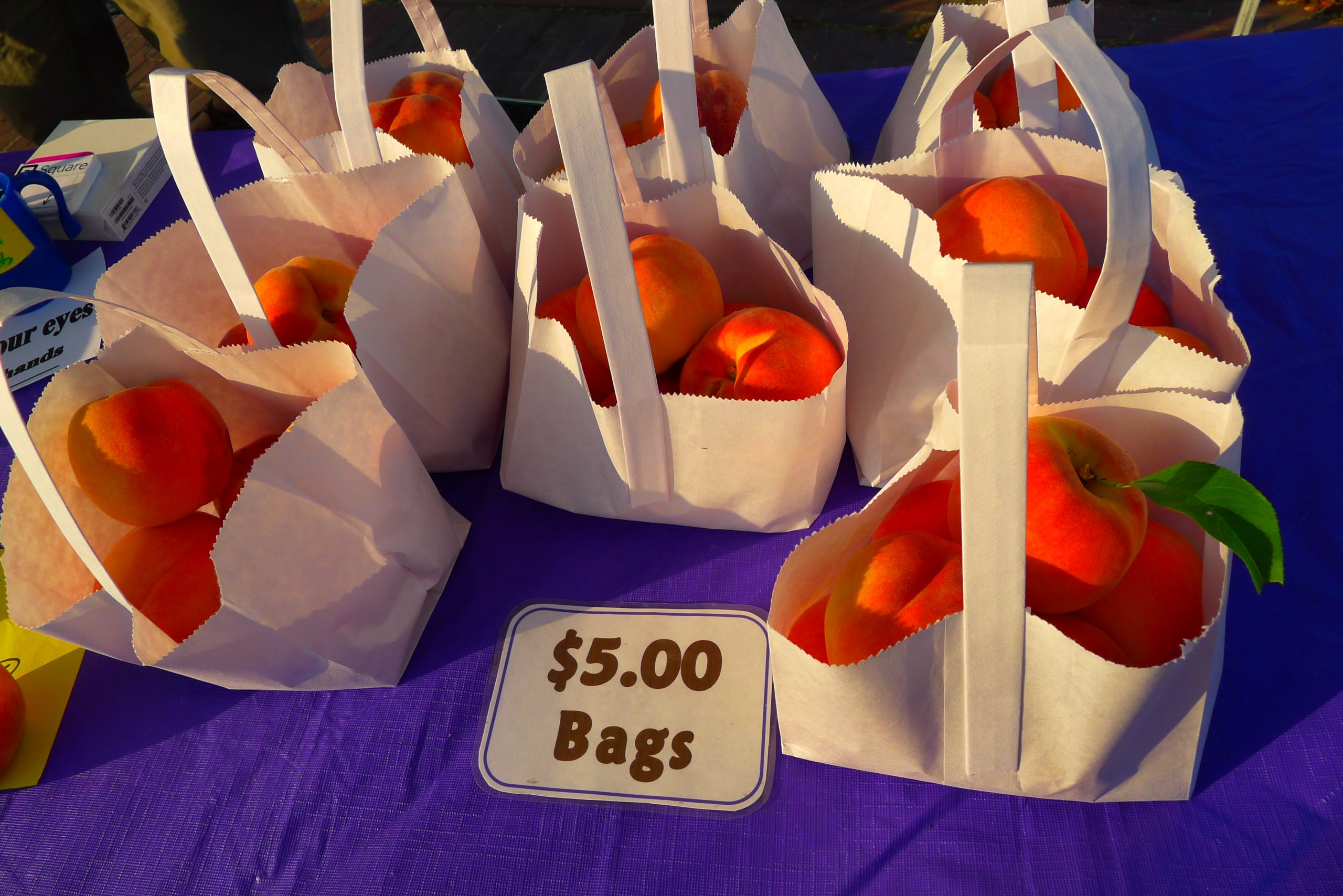Image Downloads: Peaches at Market Grilled Peach #1 Grilled Peach #2 Grill with Peaches and Corn
Many more image options available on request
Return to Editor’s Lounge
Copyright Ari LeVaux 2020. No reprints or sharing without permission

Preaching about Peaches
A tree ripened peach needs nothing but a place for the juice to drip after your face dives into it. It is like no other fruit, with a complex bouquet of flavors that changes from peach to peach, fine-tuned by the subtle weather patterns that are different each summer. When allowed to properly ripen on a tree, the flavor of a ripe peach is joyfully explosive, which is why the orchard that grows the world’s best peaches is often the one closest to your house.
Once you’ve gotten used to properly ripened peaches, the store-bought alternatives quickly lose their appeal. That disappointment in the available peaches is what inspired Tom and Lynn McCamant, my peach growers here in Montana, to start Forbidden Fruit Orchard, which might literally grow the best peaches in the world. No, really.
I buy their peaches by the boxload, at both Tuesday and Saturday markets in Missoula. Whether I’m enjoying them fresh or preserving them at the peak of freshness for later use, there are few local foods as shockingly special as peaches and decidedly superior to the imported version as peaches, and now is the time to get on it.
For both preserving and cooking, look for free-stone peaches, the flesh of which easily relinquishes the seed. The other category, called clingstone, are fine for eating — you barely notice a difference. It’s impossible to tell from the outside if a peach is free- or clingstone; you have to ask.
I spend the majority of my peach-eating time leaning over the sink, my face plunging repeatedly into juicy, messy peach flesh. But when peaches are in season, we can afford to mess around. Tom’s favorite way is diced with heavy cream (40% fat — the stuff at Costo in the half-gallon cartons).
I used to forever be on the hunt for new ways to preserve my peaches, so as to enjoy their sweet glory through winter. I’d can them in quart jars, spending hours in the steamy kitchen blanching and peeling and sealing bright orange peach halves in syrup, or putting away pints of jam, sometimes with blueberries or huckleberries. I finally settled on peach slices in the dehydrator as my go-to peach storage technique. Each slice is like a drop of sunshine, and they are among the most treasured items in my freezer.
During the deliciously long evenings of summer, when the coals are still warm, I’ve been laying peach halves on the grill, fuzzy-sides down. Sometimes I’ll add pieces of chopped ham and pickled peppers to the spot where the pit used to be, and top it with cheese. When the cheese melts, I’ll sometimes drizzle balsamic vinegar or reduction. The blend of fatty, fruity and savory flavors has the wide ranging complexity of bacon-wrapped cheese-stuffed fig.
I asked Tom if he’d ever tried grilling peaches, and he admitted that he had not. But he told me about a dish called peach sambal. By the time Lynn sent me the recipe I had already gotten involved with another peach sambal recipe which I’d met online. It calls for a spicy Indonesian red pepper and garlic paste called sambal oelek, which is available in most Asian grocery aisles. It also has lots of turmeric.
I’ve been making it with chicken, marinating whole quarters in fresh garlic, lemon, turmeric and other flavorings, along with crushed peaches, and then grilling or broiling the chicken. The balance between the turmeric, peach and chile paste is otherworldly. Only available in this world for a short, peachy time.
Peach Sambal with chicken
Lots of people want to eat turmeric these days, as it is thought to reduce inflammation in joints and elsewhere. It’s the main component of curry powder, and accordingly makes this dish taste curry-like. You can substitute curry powder of your choice for the turmeric.
Serves 4
3 pounds chicken pieces or quarters
½ cup fresh lemon juice
¼ cup sambal oelek (or less, depending on your spice tolerance)
¼ cup oyster or fish sauce
2 tablespoons sesame oil
¼ cup olive oil
3 teaspoons turmeric or curry powder
4 extra ripe peaches, cut into 1/8ths (peeled or not)
½ cup heavy cream or coconut milk
2 tablespoons soy sauce
Salt and pepper to taste
Add lemon juice, sambal oelek, oyster sauce and sesame oil to a small mixing bowl and whisk together. Rub the chicken with olive oil and add the rest of the oil to the sauce. Rub the chicken pieces with turmeric. Pour the marinade over the chicken in a large mixing bowl.
Squeeze the peaches and add them to the bowl, and mix it all together with your hands, squeezing the juice from the peaches as you mix. Let sit for at least three hours, covered in the fridge; preferably overnight.
Grill the chicken — or broil, if you don’t have a grill available. Let it cook until the skin blackens and blisters.
While it cooks, add the remaining sauce to a pan along with the heavy cream or coconut milk, and bring it to a simmer. Season with soy sauce and black pepper.
When the chicken is done, pour the sauce over the chicken and serve. Enjoy the glorious combination of blackened, blistered skin and sweet, tangy, quietly complex, decidedly peachy sauce.
And if you have room for more, throw a few peach halves on the embers of summer.